About the Author
ONCE IN A GREAT WHILE ON THIS EARTH THERE ARISES A SOUL WHO, BY LIVING HIS TRADITION RIGHTLY AND WHOLLY, PERFECTS HIS PATH AND A BECOMES A LIGHT TO THE WORLD. Satguru Sivaya Subramuniyaswami (1927-2001) was such a being, a shining example of awakening and wisdom, a leader recognized worldwide as one of Hinduism’s foremost ministers. ¶As a youth, he was trained in classical Eastern and Western dance and in the disciplines of yoga. Becoming the premier danseur of the San Francisco Ballet by age 19, he renounced the world at the height of his career and traveled to India and Sri Lanka in quest of Absolute Truth. In the caves of Jalani in 1949, he fasted and meditated until he burst into enlightenment. Soon thereafter, he met his satguru, Sage Yogaswami, who gave him the name Subramuniya, initiated him into the holy orders of sannyāsa and ordained him into his lineage with a tremendous slap on the back, saying, “This sound will be heard in America! Now go ’round the world and roar like a lion. You will build palaces (temples) and feed thousands.” While in Sri Lanka, he founded Saiva Siddhanta Church, the world’s first Hindu church, now active in many nations. In late 1949 he sailed back to America and embarked on seven years of ardent, solitary yoga and meditation which brought forth faculties of clairvoyance and clairaudience, culminating in Cognizantability, a collection of profound aphorisms and commentary on the states of mind and esoteric laws of life. In 1957, Subramuniyaswami, affectionately known as Gurudeva, founded Himalayan Academy and opened America’s first Hindu temple, in San Francisco. He formed his monastic order in 1960. In Switzerland, 1968, he revealed Shūm, a mystical language of meditation that names and maps inner areas of consciousness. From 1967 to 1983 he led fourteen Innersearch pilgrimages, guiding hundreds of devotees to the world’s sacred temples and illumined sages. In 1970 Gurudeva established his world headquarters and monastery-temple on Kauai, northernmost of the Hawaiian Islands. Beginning in the 1970s and continuing to 2001, he gave blessings to dozens of groups to build temples in North America, Australia, New Zealand, Europe and elsewhere, gifting Deity images, usually of Lord Gaṇeśa, to 36 temples to begin the worship. Over the years, he personally guided groups of trustees through each stage of temple development. He thus authenticated and legitimized the establishment of the temple as essential to any Hindu community. His relentless drive to establish Hindu worship in the West was based on his revelatory mystic visions of the Gods not as symbolic depictions but as real beings who guide and protect mankind, with whom we can commune most effectively through consecrated temples. ¶In 1973, after establishing Kadavul Temple, he clairvoyantly read from inner-plane libraries to bring forth Lemurian Scrolls and other esoteric writings to guide his monastic order and revive the centrality of celibacy and sexual transmutation. In 1975, following a powerful vision of Lord Śiva, he conceived the San Marga Iraivan Temple on Kauai as the first all-granite temple established outside of India. In 1977 he intensified requirements for his Western devotees to sever all prior religious, philosophical loyalties, legalize their Hindu name and formally enter Hinduism through the name-giving rite. In 1979 he published Holy Orders of Sannyāsa, defining the ideals, vows and aspirations of Hindu monasticism with unprecedented clarity. That same year, he began publishing HINDUISM TODAY magazine. His international Hindu renaissance tours in the early ’8os revealed that Hindus were not globally connected or organized. Those in India knew little of their brothers and sisters in South America. Those in Fiji had no knowledge of Hindus in Europe or Mauritius. Seeing this need, Gurudeva focused his journal on uniting all Hindus, regardless of nationality or sect, and inspiring and educating seekers everywhere. Also in 1979, he produced the first edition of his Hindu catechism, later to become Dancing with Śiva. ¶His travels in the 1980s brought him face to face with hundreds of thousands of Hindus, most notably in Sri Lanka, India, Malaysia and Mauritius, to whom he spread a powerful message of courage and was instrumental in regenerating pride of heritage. In the early ’8os he established the antiquity and legitimacy of monistic Śaiva Siddhānta at international conferences among pundits who had insisted that Siddhānta is solely pluralistic. In 1985 Gurudeva adopted Apple’s Macintosh-based publishing technology to supercharge his prolific outreach through scriptures, books, pamphlets, art, lessons and later through CDs and the world’s foremost Hindu websites. ¶In 1986 he founded a branch monastery in Mauritius, whose government had invited him there to revive a languishing Hindu faith. That same year, New Delhi’s World Religious Parliament named him one of five modern-day Jagadāchāryas, world teachers, for his international efforts in promoting a Hindu renaissance. Also in 1986 he created Pañcha Gaṇapati, a five-day Hindu festival celebrated around the time of Christmas. In 1987 he published God’s Money to explain tithing and how it is practiced by members of his Hindu church. The year 1989 saw the culmination of numerous books and pamphlets that later became part of the Master Course trilogy. In 1991 in Bangalore, he ceremoniously chipped the first stone of Iraivan temple and established a small village where craftsmen and their families could live and carve this architectural gem by hand over the next fifteen years. In 1991 he produced the Nandinātha Sūtras, 365 aphorisms outlining the entire gamut of virtuous Hindu living. In 1994 Gurudeva founded Hindu Heritage Endowment, now a multi-million-dollar public service trust that establishes and maintains permanent sources of income for Hindu institutions worldwide. In 1995 he published the final edition of Śaiva Dharma Śāstras, drawing on aspects of the American church system to make his organization socially viable and structurally effective. Therein he finalized patterns for the future, including the extended family structure for his missions, and designated as his successors three of his senior monastics: Acharya Veylanswami, followed by Acharya Palaniswami and then Acharya Ceyonswami. ¶From 1977 to 2001 Gurudeva nurtured a staunchly Hindu, highly disciplined, global fellowship of family initiates, monastics and students, training them to follow the sādhana mārga, the path of yogic striving and personal transformation, and to assist him in his global mission. With this competent team and a sophisticated infrastructure, his Church nurtures its membership and local missions on five continents and serves, personally and through publications and the Internet, the community of Hindus of all sects. It furthers the dual mission of Hindu solidarity and monistic Śaiva Siddhānta, vowing to protect, preserve and promote the Śaivite Hindu religion as expressed through three pillars: temples, satgurus and scripture. The recognized hereditary guru of 2.5 million Sri Lankan Hindus, Gurudeva proclaimed his Church a Jaffna-Tamil-based organization which branched out from the Sri Subramuniya Ashram in Alaveddy to meet the needs of the growing Hindu diaspora of this century. It gently oversees some 40 temples worldwide. Missionaries and teachers within the family membership provide counseling and classes in Śaivism for children, youth and adults. Gurudeva’s numerous books present his unique and practical insights on Hindu metaphysics, mysticism, culture, philosophy and yoga. His Śaivite Hindu Religion children’s course is taught in many temples and homes, preserving the teachings in five languages for thousands of youths. ¶In 1995, in Delhi, the World Religious Parliament bestowed on him the title Dharmachakra for his remarkable publications. The Global Forum of Spiritual and Parliamentary Leaders for Human Survival chose him as a Hindu representative at its momentus conferences. Thus, at Oxford in 1988, Moscow in 1990 and Rio de Janeiro in 1992, he joined religious, political and scientific leaders from all countries to discuss the future of human life on this planet. At Chicago’s historic centenary Parliament of the World’s Religions in September, 1993, he was elected one of three Hindus to the Presidents’ Assembly, a core group of 25 men and women voicing the needs of world faiths. Especially in the early ’90s he campaigned for fair treatment of temple priests, namely the same respect enjoyed by the clergy of other religions. From 1996 onward, Gurudeva was a key member of Vision Kauai 2020, a group of inspirers (including the Mayor, county council, business and education leaders) that meets to fashion the island’s future based on spiritual values. In 1998 he responded to President Clinton’s call for religious opinions on the ethics of human cloning. That same year, he spearheaded the 125th anniversary of Satguru Yogaswami and his golden icon’s pilgrimage around the world, ending in Sri Lanka. During these final years he worked daily in the morning hours in refining the Shūm language as his supreme gift to his monastic order. ¶In 1998 Gurudeva began an ardent campaign for the right of children to not be beaten by their parents or their teachers, helping parents raise children with love through Positive Discipline classes taught by his family devotees as their primary community service. In 1999 he traveled to Mauritius to publicly inaugurate his Spiritual Park as a gift to the island nation. In he published How to Become a Hindu, showing the way for seekers to formally enter the faith, refuting the dogma that “You must be born a Hindu to be a Hindu.” On August 25, 2000, he received the prestigious United Nations U Thant Peace Award in New York (previously bestowed on the Dalai Lama, Nelson Mandela, Mikhail Gorbachev, Pope John Paul II and Mother Teresa). He addressed 1,200 spiritual leaders gathered for the UN Millennium Peace Summit, with the message, “For peace in the world, stop the war in the home.” Upon his return to Kauai, 350 citizens and county and state officials gathered to herald his accomplishments on the island and beyond. Governor Benjamin Cayetano wrote: “I am especially grateful for your efforts to promote moral and spiritual values in Hawaii. May our people forever embrace the message of peace you have so eloquently supported in your gracious wisdom.” In November, 2000, Gurudeva launched Hindu Press International (HPI), a HINDUISM TODAY daily news summary for breaking news sent free via e-mail and posted on the web. In 1999, 2000 and 2001 he conducted three Innersearch journeys, taking devotees to Alaska, the Caribbean and Northern Europe, consecrating new temples in Alaska, Trinidad and Denmark. In 2001 he completed his golden legacy, the 3,000-page Master Course trilogy of Dancing, Living and Merging with Śiva—peerless volumes of daily lessons on Hindu philosophy, culture and yoga, respectively. ¶For fifty years, Subramuniyaswami taught Hinduism to Hindus and seekers from all faiths. Known as one of the strictest gurus in the world, he was the 162nd successor of the Nandinātha Kailāsa lineage and satguru of Kauai Aadheenam, his 458-acre temple-monastery complex on the Garden Island of Kauai. From this verdant Polynesian aśrama on a river bank near the foot of an extinct volcano, his monastics continue to promote the dharma together through Saiva Siddhanta Church, Himalayan Academy and Hindu Heritage Endowment, perpetuating the mission given to Gurudeva by his satguru. ¶Gurudeva departed from this world as courageously as he had lived in it. Learning on October 9, 2001, that he had advanced, metastacized intestinal cancer, confirmed by a host of specialists in three states, all concurring that even the most aggressive treatment regimens would not prove effective, he declined any treatment beyond palliative measures and decided to follow the Indian yogic practice, called prāyo-paveśa in Sanskrit scripture, to abstain from nourishment and take water only from that day on. He left his body peacefully on the 32nd day of his self-declared fast, at 11:54 pm on Monday, Chitra nakshatra, November 12, 2001, surrounded by his twenty-three monastics. Gurudeva consoled them, “Don’t be sad. When I am gone from this world, I will be working with you on the inside twenty-four hours a day.” The rock-solid foundation for the continuance of his work is Kauai Aadheenam and its resident Saiva Siddhanta Yoga Order. This group of twelve initiated swāmīs with lifetime vows and nine brahmachārīs, celibate monks, come from six countries and include both men born into the Hindu religion and those who converted or adopted Hinduism—Asians and Westerners—made strong by decades of Gurudeva’s loving but strict personal guidance and insistence on 110 percent performance. In the first weeks of his fast, Gurudeva seamlessly transferred his duties and responsibilities to his chosen successor, Satguru Bodhinatha Veylanswami, 59, a disciple for 37 years, declaring, “Bodhinatha is the new satguru now.” Ever concerned for others, even on his deathbed, just days before his Great Union, he whispered in assurance, “Everything that is happening is good. Everything that is happening is meant to be.” He asked devotees worldwide to carry his work and institutions forward with unstinting vigor, to keep one another strong on the spiritual path, to live in harmony and to work diligently on their personal spiritual sādhanas. “You are all over-qualified to carry on.” ¶When notified of Gurudeva’s passing, Sita Ram Goel, one of India’s most influential Hindu writers and thinkers, wrote, “He has done great work for Hinduism, and the recent reawakening of the Hindu mind carries his stamp.” Ma Yoga Shakti, renowned yoga teacher, said, “For more than five decades, Subramuniyaswami, a highly enlightened soul of the West—a Hanuman of today, a reincarnation of Śiva Himself—has watered the roots of Hinduism with great zeal, faith, enthusiasm and whole-heartedness.” Sri Shivarudra Balayogi Maharaj of India said, “By his life and by his teaching, Satguru Sivaya Subramuniyaswami has helped make Hinduism an even greater gift to humanity.” From Jaffna, president of Sivathondan Nilayam Arunasalam Sellathurai Swamigal wrote: “The life, mission and mandate of His Holiness Sivaya Subramuniyaswami form an epic chapter in his unending spiritual quest leading him to the founding of the Saiva Siddhanta Church and a monastic order in Hawaii—a magnificent task! This will ever remain a monument to his spiritual fervor, proclaiming worldwide, East and West, in trumpet tones that Swamigal was a trailblazer of Lord Śiva’s choice to glorify the spiritual heritage and the essence of Śaiva Siddhānta.” ¶Gurudeva’s life was one of extraordinary accomplishments on so many levels; but his greatest siddhi, to which thousands of devotees will testify, was his incredible power to inspire others toward God, to change their lives in ways that are otherwise impossible, to be a light on their path, a mother and father and friend to all who drew near. Gurudeva lived so profoundly at the center of himself, so close to the core of being, the heart of Divinity, that everyone he met felt close to him. He personified the pure, blissful soul nature they sought and sensed as the center of themselves.§
Milestones of His 52-Year Ministry
Enumerating a Spiritual Master’s Many Gifts to Mankind§
Empowered by his Self Realization, his ordination as a satguru and the blessings of Gods and devas, Gurudeva contributed to the revival of Hinduism in immeasurable abundance. He was simultaneously a staunch defender of traditions, as the proven ways of the past, and a fearless innovator, rivaling the ṛishis of Vedic times in instilling fresh understanding and setting new patterns of life for contemporary humanity. Here is a partial list of his trail-blazing mission and accomplishments.§
SPIRITUAL TEACHINGS
- Bringing seekers new meaning to life through The Master Course as a path of self-transformation through sādhana, a self-initiated journey to bravely, cheerfully face the karma one has created in the past.
- Pioneering the language Shūm in 1968 to enhance seekers’ yogic efforts and vigorously developing it from 1995 to 2001, as his choicest inner gift to his monastics.
- Bringing the Gods “out of exile” by explaining and writing about the mysteries of temple worship and the three worlds of existence from his own experience.
- Unfolding theological summations for a religion in renaissance, such as “Four Facts of Hinduism,” “Nine Beliefs,” “Hinduism’s Code of Conduct,” the 365 Nandinatha Sūtras, and a Hindu catechism and creed.
- Bringing forth Lemurian Scrolls and other esoteric writings from inner-plane libraries to guide his monastic order and revive the centrality of celibacy and sexual transmutation.
- Translating and publishing Tiruvalluvar’s ethical masterpiece, the Tirukural, in modern, lucid English.
LEADING THE HINDU RENAISSANCE
- Building Hindu pride; convincing Hindus everywhere to stand up and proclaim themselves Hindus and stop repeating equivocal slogans like, “I’m not really a Hindu. I am a universalist—a Christian, a Jew, a Muslim and a Buddhist.”
- Proclaiming that Hinduism is a great, living religion, not a archeologic relic of the past as oft depicted by Western scholars—one that should be presented by Hindu writers, as he did in his peerless publications.
- Teaching Hinduism to Hindus, awakening their self-appreciation as a world community, blessed inheritors of a grand civilization and culture, indeed, the religion best suited to the new age.
- Rescuing the word Hinduism from its fallen status as a dirty word and restoring it to its age-old glory.
- Heralding sectarianism when the prevailing trend was bland uniformity, insisting that only if each denomination is strong and faithful to its unique traditions will Hinduism itself be strong.
- Championing the centrality of temples, legitimizing their establishment, and authenticating their purpose.
CORRECTIVE CAMPAIGNS
- Dispelling myths and misinformation about Hinduism through HINDUISM TODAY for two decades.
- Promoting the Vedas and Āgamas as the holy bible of Hinduism, rather than the mythological Purāṇas and the historical Bhagavad Gītā.
- Establishing rational mystical explanations for Hindu practice to displace the Purāṇic “comic book” mentality.
- Reinstating ahiṁsā, noninjury, as the cardinal ethic of Hinduism when militants were promoting righteous retaliation, often by citing the Bhagavad Gītā.
- Rejecting traditional stories that glorify violence, such as many found in the Periyapuranam.
- Repopularizing Śiva as a God of love to be worshiped by all devotees, not a fearsome being approached only by ascetics. Assuring Hindus it is all right, in fact necessary, to have Lord Śiva in the home.
- Speaking for the purity of Hindu monasticism and against the idea of “married swāmīs” and mixed-gender āśramas.
- Campaigning against the use of illegal drugs by exposing the harmful effects and karmic consequences.
- Combatting unethical Christian conversion by enhancing Hindu education, exposing the devious tactics of evangelists and the immaturity of faiths that consider theirs the only true path and aggressively seek to compel others to adopt it.
- Debunking the notion that “All religions are one” and publishing a comparative summary of the major religions of the world, side by side with prominent secular philosophies.
- Enjoining temple boards of trustees to get along with each other, to beware of detractors and to establish teaching programs for the youth.
RELIGIOUS STATESMANSHIP
- Providing a fearless, outspoken Hindu voice at interfaith conferences and spiritual and political forums, objecting to Christian hegemony at such gatherings, calling for equal representation by other religions, including the indigenous peoples, and decrying the hypocrisy of scientists who would speak as potential saviors for Earth’s problems when science itself had caused many of the predicaments.
- Defending advaitic Śaiva Siddhānta at international conferences and with pundits of South Indian aadheenams to successfully affirm the legitimacy and antiquity of the nondual theology which so perfectly reflected his own realizations.
- Creating a method of ethical self-conversion for seekers to formally enter the Hindu religion, insisting that Hinduism has always accepted newcomers, refuting the notion that “You must be born a Hindu to be a Hindu.”
- Encouraging people to practice their religion, whatever it may be, rather than nonreligious paths such as materialism, communism, existentialism and secular humanism.
PIONEERING PATTERNS
- Harnessing information technology to drive Hindu Dharma into the new millennium, including setting up the first Macintosh publishing network (1986) and founding the first major Hindu website (1994). In 1997 he launched TAKA, “Today at Kauai Aadheenam,” to chronicle daily activities at his Kauai and Mauritius centers. He observed, “Now we have computers and the Internet—modern technology capable of bringing the spiritual beings and all religious people of the world closely together wherever they live. This one thing the typewriter could not do, the pen and paper could not do, the stylus and olai leaf did not do.”
- Calling for the establishment of schools, pāṭhaśālas, to train temple priests outside of India.
- Promoting the idea of resident facilities for the elderly to live together close to temples in the West.
- Gifting Deity icons, usually of Gaṇeśa, to initiate the worship and remove obstacles at 36 temples globally.
- Establishing perpetual funds to finance his own and others’ religious endeavors through Hindu Heritage Endowment.
- Finding ways for Hindus to meet cultural dilemmas in the modern age, such as devising a new festival, Pañcha Gaṇapati, celebrated for five days around the time of Christmas.
- Supporting cross-national marriages within his congregation and to the wider Hindu world.
- Drawing from the American church system to make his organization, and other Hindu institutions, socially viable, legally strong and structurally effective.
- Encouraging selfless, religious giving of one’s time, resources and finances, and establishing tithing as a monthly practice within his global congregation.
- Establishing Innersearch Travel Study as a means of self-discovery and spiritual renewal for devotees and students, with his last three journeys consecrating new temples in Alaska, Trinidad and Denmark.
- Distinguishing outstanding leadership with his Hindu of the Year award.
- Introducing to Kauai: Toggenberg goats, Jersey cows, the honey bee industry and many species of exotic flora.
REVIVING NOBLE TRADITIONS
- Bringing sacraments, saṁskāras, back into vogue through his writings and by implementing them among his congregation with reverence and formal documentation.
- Campaigning for priests’ rights and fair treatment, demanding they receive the same respect enjoyed by the clergy of other religions.
- Supporting and reviving the traditional arts, especially South Indian painting, with which he illustrated his trilogy; Indian dance, which he and his followers learned and taught; temple architecture, which he embodied in Iraivan Temple; Vedic astrology, which he used daily for its insights into character of people and timing of events; and āyurveda, which he promoted in his publications and encouraged as a natural healing system for his followers.
- Rescuing the home shrine from extinction—“out of the closet, into the most beautiful room of the home.”
STRENGTHENING MONASTICISM
- Garnering respect for Hindu monastics of every order when “swāmī bashing” was common, proclaiming that swāmīs and sādhus are the ministers of this noble faith and that genuine gurus should be venerated, obeyed and sought out for their wisdom.
- Creating a global enclave of several hundred Hindu leaders and regularly calling on them for their wisdom on critical issues, from abortion, to cloning, to medical ethics and Hindu family life, publishing their collective views in HINDUISM TODAY.
- Breathing new life into the aadheenams of South India (temple-monastery complexes), bringing new prominence to the Saṅkarāchārya centers and to the seats of power of all monastic lineages.
- Codifying in his Holy Orders of Sannyāsa the ideals, vows and aspirations of Hindu monasticism in unprecedented clarity and detail.
IMPROVING FAMILY LIFE
- Upholding the integrity of the family, extolling the extended family, finding ways to keep families close and harmonious, declaring that divorce is never a happy solution to marital conflict.
- Denouncing and taking action against wife abuse as a despicable act that no man has the right to perpetrate.
- Insisting on “zero tolerance for disharmonious conditions” within his monasteries and the homes of followers.
- Protecting children from abuse, standing up for their right to not be beaten by parents or teachers and debunking the notion that corporal punishment is a part of Hindu culture.
- Helping parents raise children with love and respect through Positive Discipline classes taught by his family devotees as a primary service to the community.
- Establishing a counter “women’s liberation movement,” reminding Hindus that family well-being lies in the hands of women, who with their special śakti are uniquely able raise their children well and make their husbands successful by not working in the world, but following the traditional role of wife and mother.
SETTING STANDARDS IN LEADERSHIP
- Creating Kauai Aadheenam, a temple-monastery in Hawaii so traditional and spiritual—replete with two Śiva temples, a large monastic order and a satguru pīṭha (seat of authority), all amid religious art, sculpture, traditional temple architecture and liturgy—that it stands as the most authoritative aadheenam in the West.
- Manifesting Iraivan, the first all-stone Āgamic temple in the West.
- Initiating and nurturing a traditional order of two dozen celibate Śaiva monastics, molding them into an effective, harmonious, traditional multi-national team.
- Building two platforms: Hindu solidarity, which he promoted through HINDUISM TODAY, and monistic Śaiva Siddhānta, which he elucidated in his eloquent and prolific publications.
- Being always available: personally greeting thousands of Hindu visitors to his aadheenam, speaking with them about their lives, concerns and aspirations.
- Fulfilling the motto “Think globally, act locally,” joining monthly with Kauai leaders in an island visioning group to help manifest an enhanced social and economic future.
There are a few unusual men who have had enough of worldliness and choose to dance, live and merge with Śiva as Hindu monks.
 hese rare souls follow the path of the traditional Hindu monastic, vowed to poverty, humility, obedience, purity and confidence. They pursue the disciplines of charyā, kriyā, yoga and jñāna that lead to Self Realization. Knowing God is their only goal in life, the power that drives them tirelessly on. They live with other maṭhavāsis like themselves in monasteries, apart from worldliness, to worship, meditate, serve and realize the truths of the Vedas and Śaiva Āgamas. Guided by Satguru Bodhinatha Veylanswami, successor to Satguru Sivaya Subramuniyaswami, and headquartered at Kauai Aadheenam in Hawaii, USA, on the beautiful Garden Island of Kauai, the Saiva Siddhanta Yoga Order is among the world’s foremost traditional Śaivite Hindu monastic orders, accepting candidates from every nation on Earth. It is an advaitic Śaiva Siddhānta order, a living stream of the ancient Nandinātha Sampradāya, originally deriving from India, and in recent centuries based in Sri Lanka. Young men considering the renunciate path who strongly believe they have found their spiritual calling in this lineage are encouraged to write to Bodhinatha, sharing their personal history, spiritual aspirations, thoughts and experiences. Holy orders of sannyāsa may be conferred on those who qualify after ten to twelve years of training. Write to:§
hese rare souls follow the path of the traditional Hindu monastic, vowed to poverty, humility, obedience, purity and confidence. They pursue the disciplines of charyā, kriyā, yoga and jñāna that lead to Self Realization. Knowing God is their only goal in life, the power that drives them tirelessly on. They live with other maṭhavāsis like themselves in monasteries, apart from worldliness, to worship, meditate, serve and realize the truths of the Vedas and Śaiva Āgamas. Guided by Satguru Bodhinatha Veylanswami, successor to Satguru Sivaya Subramuniyaswami, and headquartered at Kauai Aadheenam in Hawaii, USA, on the beautiful Garden Island of Kauai, the Saiva Siddhanta Yoga Order is among the world’s foremost traditional Śaivite Hindu monastic orders, accepting candidates from every nation on Earth. It is an advaitic Śaiva Siddhānta order, a living stream of the ancient Nandinātha Sampradāya, originally deriving from India, and in recent centuries based in Sri Lanka. Young men considering the renunciate path who strongly believe they have found their spiritual calling in this lineage are encouraged to write to Bodhinatha, sharing their personal history, spiritual aspirations, thoughts and experiences. Holy orders of sannyāsa may be conferred on those who qualify after ten to twelve years of training. Write to:§
Satguru Bodhinatha Veylanswami
Guru Mahāsannidhānam, Kauai Aadheenam
107 Kaholalele Road, Kapaa, Hawaii 96746-9304 USA
E-mail: Bodhi@hindu.org
World Wide Web: www.Gurudeva.org§
The Hindu Heritage Endowment
 indu thought and culture thread through almost every civilization on the planet, weaving a subtle tapestry of lofty philosophy and earthy, pragmatic wisdom. Whose life has not been touched? Some have been raised in India and enjoy memories of warm extended families and cool temples resounding with ancient mantras. Others find peace of mind in Hindu yoga practices. Many find solace in the concepts of karma, dharma and reincarnation, which express their own inner findings and beliefs. If you are one who has been touched by Hindu thought and culture, you may wish to further enrich your life by giving back to Sanātana Dharma in countries around the globe and helping preserve its rich heritage for future generations. ¶Hindu Heritage Endowment (HHE) provides such an opportunity. A public charitable trust recognized by the United States government, HHE was created to maintain permanent endowments for Hindu projects and institutions worldwide. Its endowments benefit orphanages, children’s schools, āśramas and temples. They support priests and publish books; and they are designed to continue giving that financial support year after year, decade after decade, century after century. Whether you are inspired to give a few dollars to support orphanages or bequest millions in your will, write, give us a call or look us up on the Internet. Find out how to enrich your life by helping to preserve the treasures of a profound heritage for generations now living or as yet unborn.§
indu thought and culture thread through almost every civilization on the planet, weaving a subtle tapestry of lofty philosophy and earthy, pragmatic wisdom. Whose life has not been touched? Some have been raised in India and enjoy memories of warm extended families and cool temples resounding with ancient mantras. Others find peace of mind in Hindu yoga practices. Many find solace in the concepts of karma, dharma and reincarnation, which express their own inner findings and beliefs. If you are one who has been touched by Hindu thought and culture, you may wish to further enrich your life by giving back to Sanātana Dharma in countries around the globe and helping preserve its rich heritage for future generations. ¶Hindu Heritage Endowment (HHE) provides such an opportunity. A public charitable trust recognized by the United States government, HHE was created to maintain permanent endowments for Hindu projects and institutions worldwide. Its endowments benefit orphanages, children’s schools, āśramas and temples. They support priests and publish books; and they are designed to continue giving that financial support year after year, decade after decade, century after century. Whether you are inspired to give a few dollars to support orphanages or bequest millions in your will, write, give us a call or look us up on the Internet. Find out how to enrich your life by helping to preserve the treasures of a profound heritage for generations now living or as yet unborn.§
107 Kaholalele Road, Kapaa, Hawaii, 96746-9304, USA.
Phone: (800) 890-1008; Outside of the US: (808) 822-3012, ext. 228
Fax: (808) 822-3152; E-mail: HHE@hindu.org
World Wide Web: www.HHEonline.org
The Mini-Mela Giftshop
For all our books, visit minimela.com§
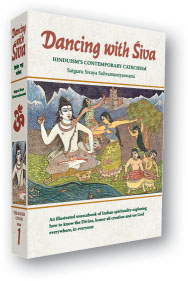 Dancing with Śiva
Dancing with Śiva
Hinduism’s Contemporary Catechism
Book 1 of The Master Course Trilogy
By Satguru Sivaya Subramuniyaswami§
This remarkable 1,000-page sourcebook covers every subject, answers every question and quenches the thirst of the soul for knowledge of God and the Self. Clearly written and lavishly illustrated, expertly woven with 600 verses from the Vedas, Āgamas and other holy texts, 165 South Indian paintings, 40 original graphics, a 25-page timeline of India’s history and a 100-plus-page lexicon of English, Sanskrit and Tamil. A spiritual gem and great value at twice the price. “The most comprehensive and sensitive introduction to the living spiritual tradition of Hinduism, …a feast for the heart and the mind (Georg Feuerstein).” Sixth edition, 2003, 7" x 10", full color, case bound (ISBN 0-945497-96-2), US$59.95.§
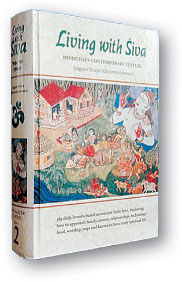 Living with Śiva
Living with Śiva
Hinduism’s Contemporary Culture
Book 2 of The Master Course Trilogy
By Satguru Sivaya Subramuniyaswami§
In the same bold, candid style of Merging with Śiva, Gurudeva focuses here on Hinduism’s twenty restraints and observances that when dynamically applied bring order in life and establish a foundation for spirituality, meditation and realization. He addresses frankly and offers sound advice on the various problematic areas of modern living. The book is conveniently structured in 365 daily lessons disclosing how to approach family, money, relationships, technology, food, worship, yoga and karma to live a truly spiritual life. Second edition, beautiful full color art throughout, haṭha yoga and religious dues resources. Second edition, 2001, 7" x 10", case bound (ISBN 0-945497-98-9), US$59.95.§
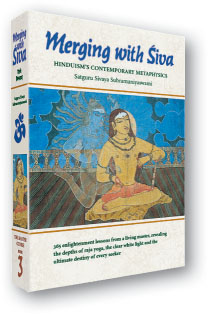 Merging with Śiva
Merging with Śiva
Hinduism’s Contemporary Metaphysics
Book 3 of The Master Course Trilogy
By Satguru Sivaya Subramuniyaswami§
Here is the ultimate text for the really serious seeker. It may well go down in history as the richest and most inspired statement of meditation and God Realization ever, in any language. Yet, it’s user-friendly, easy to follow, sensible and nonacademic! Merging with Śiva is 365 daily lessons, one for each day of the year, about the core of your own being. It’s about God, about the mystical realm of the fourteen chakras, the human aura, karma, force fields, thought and the states of mind, the two paths, samādhi and so much more. Illustrated with fifty original South Indian paintings. Second edition, 2001, 1,000 pages, 7" x 10", case bound (ISBN 0-945497-99-7), US$59.95.§
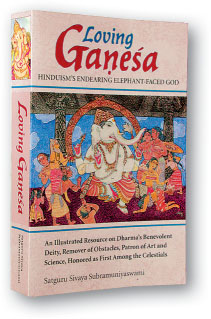 Loving Gaṇeśa
Loving Gaṇeśa
Hinduism’s Endearing Elephant-Faced God
By Satguru Sivaya Subramuniyaswami§
No book about this beloved elephant-faced God is more soul-touching. The Lord of Dharma will come to life for you in this inspired masterpiece. It makes approaching this benevolent Lord easy and inspiring. Learn about Gaṇeśa’s powers, pastimes, mantras, nature, science, forms, sacred symbols, milk-drinking miracle and more. “A copy of Loving Gaṇeśa should be placed in every library and Hindu home” (Sri Om Prakash Sharma). Second edition, 1999, 576 pages, 5½" 8½", softcover (ISBN 0-945497-77-6), US$29.85.§
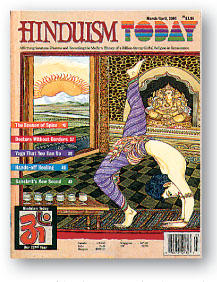 Hinduism Today
Hinduism Today
The International Magazine§
Enjoy a spiritual experience with the foremost international journal on Sanātana Dharma, published by Satguru Bodhinatha Veylanswami and the swāmīs of the Saiva Siddhanta Yoga Order. Breaking news, ancient wisdom, modern trends, world-class photos, family resources, humor—you’ll treasure every issue! “HINDUISM TODAY is a beautiful example of the positive possibility of the media being fulfilled, a bright ray of light in a darkened world” (Anne Shannon, Portland). Introductory offer (US only): one-year subscription, four stunning issues, for US$35! And yes, the author of this book founded this global magazine and guided it for 20 years. ISSN 0896-0801; upc: 0-74470-12134-3. Visit: www.HinduismToday.com§
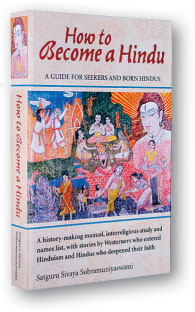 How to Become a Better Hindu
How to Become a Better Hindu
A Guide for Seekers and Born Hindus
By Satguru Sivaya Subramuniyaswami§
Hundreds of thousands of half-Hindus, having received a first name of a God or Goddess from their yoga teacher or a swāmī, want to enter the religion fully. Because of Hinduism’s liberal doctrine, it is left to the individual as a “do-it-yourself conversion.” How to Become a Hindu explains how the six steps of ethical conversion have enhanced the lives of many in the East and West. Here Americans, Canadians and Europeans tell their stories of passage from Western faiths to Hinduism. The book raises and convincingly settles the debate about non-Hindus entering the religion. “This elucidative book will provide immense help to those who wish to enter the Hindu fold, and also the younger generation of Hindus living outside India” (Puri Shankaracharya). First edition, 2000, 496 pages, 8½" x 5½", softcover (ISBN 0-945497-82-2), US$27.95.§
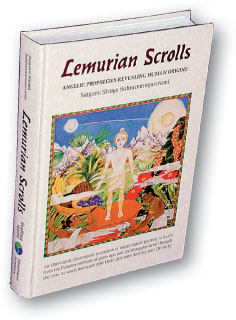 Lemurian Scrolls
Lemurian Scrolls
Angelic Prophecies Revealing Human Origins
By Satguru Sivaya Subramuniyaswami§
Enliven your spiritual quest with this clairvoyant revelation of mankind’s journey to Earth millions of years ago from the Pleiades and other planets to further the soul’s unfoldment. Learn about the ensuing challenges and experiences faced in evolving from spiritual bodies of light into human form and the profound practices followed and awakenings achieved in ancient Lemuria. These angelic prophecies, read by Sivaya Subramuniyaswami from ākāśic records written two million years ago, will overwhelm you with a sense of your divine origin, purpose and destiny and motivate a profound rededication to your spiritual quest. An extraordinary metaphysical book which answers the great questions: Who am I? Where did I come from? Where am I going? First Edition, 1998, 7½" x 10½", 400 pages, beautifully illustrated with original drawings, smythe-sewn and case bound with printed color cover (ISBN 0-945497-70-9), US$29.85.§
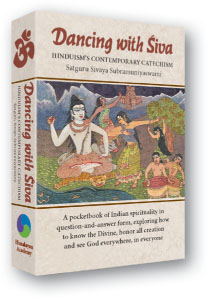 Dancing with Śiva Pocketbook
Dancing with Śiva Pocketbook
Hinduism’s Contemporary Catechism
NEW POCKETBOOK EDITION!
By Satguru Sivaya Subramuniyaswami§
Now, carry the fullness of Hindu Dharma in your shirt pocket or purse. This remarkable little gem brings forward the same 155 questions and answers on contemporary Hindu philosophy, culture and metaphysics that have become world-renowned for the clear, practical way in which they explain the world’s oldest religion to the modern seeker. Interwoven with verses from the Vedas, Āgamas and other holy texts, over 60 original graphics, a summary of Śaivite Hindu beliefs and a 750-plus-term glossary of English, Sanskrit and Tamil. First pocketbook edition, 2003, 3" x 4½", paperback (ISBN 0-945497-89-x), US$4.95.§

